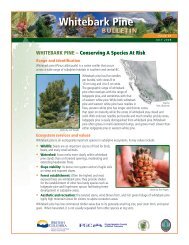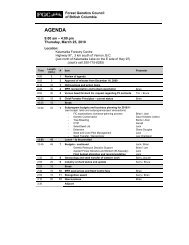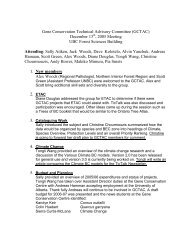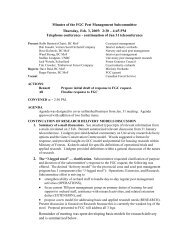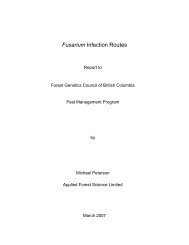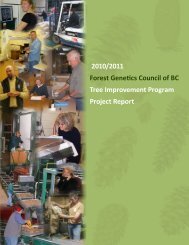Tree Improvement Program Project Report 2006 / 2007
Tree Improvement Program Project Report 2006 / 2007
Tree Improvement Program Project Report 2006 / 2007
Create successful ePaper yourself
Turn your PDF publications into a flip-book with our unique Google optimized e-Paper software.
.1. Bowser Seed Orchard<br />
Dav d Re d and Carolyn Lohr<br />
Upgrad ng<br />
The initial rogueing of advance generation orchards 149<br />
and 162 has been completed. Thirty-five ramets of 3 clones<br />
with an average BV of 23 were available for transplanting<br />
from orchard 168 into orchard 162. These trees are 13<br />
years old and already at the production stage so should<br />
contribute to orchard seedlots immediately. Thirty-three of<br />
the 35 trees were vigorous enough to be transplanted.<br />
Enhanc ng seed y eld and genet c worth<br />
Controlled pollination: Pollination bags were placed on 286<br />
branches of 21 high BV ramets in orchards 149, 162 and<br />
168. High GW pollen was applied at least twice to each<br />
tree. Seedlot 60588 yielded a collection of 1.25 hectolitres<br />
(approximately 3000 cones). Seed yield per hectolitre was<br />
not finalized at the time of writing. Estimated GW of this<br />
seedlot is 20.<br />
Induct on<br />
Suitable candidates (negligible current years’ crop; no<br />
crop last year; not induced last year; sufficient vigour and<br />
adequate number of cone-bearing sites) were identified.<br />
An induction treatment of a double overlapping girdle was<br />
applied. Irrigation was withheld until mid-July. 236 ramets<br />
from orchard 162 were induced. Bud surveys for crop<br />
year <strong>2007</strong> indicate an excellent crop in the orchards, with<br />
significantly increased production in the induced areas of<br />
orchard 162.<br />
Orchard management<br />
All orchard trees were maintained through appropriate<br />
cultural practices. Foliar nutrient samples were taken;<br />
fertilizer was applied for both growing stock and crop<br />
maintenance; irrigation was applied when required and<br />
trees transplanted into orchard 149 were staked, mulched,<br />
had irrigation lines and emitters installed, and were crownpruned<br />
to lessen transplant shock.<br />
Insect mon tor ng and control<br />
Surveys were conducted for Contarinia, Dioryctria and<br />
Leptoglossus. Due to the extremely light crop no control<br />
measures were undertaken for Contarina or Leptoglossus.<br />
T R E E I M P R O V E M E N T P R O G R A M<br />
P R O J E C T R E P O R T 2 0 0 6 / 2 0 0 7<br />
The Dioryctria trapping program was continued<br />
throughout the year, and population levels did not require<br />
control measures.<br />
.1. Kalamalka Seed<br />
Orchards<br />
Chr s Walsh<br />
In <strong>2006</strong>/<strong>2007</strong>, Kalamalka Seed Orchards received OTIP<br />
approval for 10 projects under the operational production<br />
sub-program. We received approval for a further two<br />
projects under the incremental program. The funding<br />
allowed for a significant enhancement of the effectiveness<br />
of our orchards in delivering improved seed. Activities<br />
included:<br />
• Improving orchard composition through grafting<br />
higher-breeding-value ramets, maintaining recently<br />
grafted high-value ramets destined for orchards, planting<br />
rootstock for future grafting, transplanting the older<br />
higher-value ramets to the orchards, and roguing lowervalue<br />
ramets from the orchards;<br />
• Improving orchard seed quantity and quality through<br />
pollen management, including collecting highbreeding-value<br />
pollen from clone banks and applying<br />
Supplemental Mass Pollination; and<br />
• Improving orchard productivity through pest<br />
management and other management activities.<br />
Pest management activities included:<br />
• using Safer’s Soap sprays to control galling adelgids,<br />
• removing weevil-infested spruce leaders to reduce weevil<br />
populations,<br />
• removing pine pitch moths damaging orchard tree<br />
stems,<br />
• baiting for control of rodents feeding on tree roots,<br />
• sanitation picking of cones in orchards with noncollectible<br />
crops to reduce pest populations,<br />
• applying dormant oil to control larch adelgids,<br />
• spraying to control Dioryctria in Lw cones,<br />
• spraying to control Leptoglossus, and<br />
2



